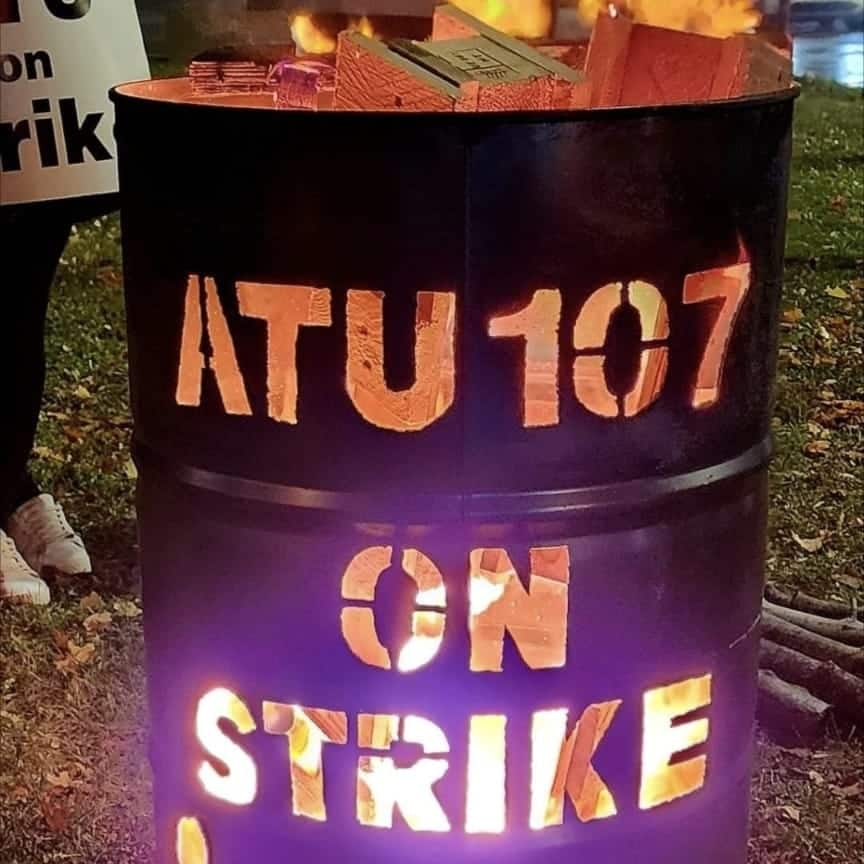Hamilton transit union rejects City’s latest invitations to return to bargaining
Published November 13, 2023 at 6:45 pm

Top Hamilton officials say that they are staying “optimistic” they will get back to the bargaining table with the transit union, though it had rejected their offer to meet again on Friday and Monday and the City is not changing its position on wages.
Wages are the main sticking point to reaching a new collective bargaining agreement for the City’s 880 Hamilton Street Railway workers who have been on strike since Nov. 9. The work stoppage suspended all bus operations. Accessible transportation services offered by the contractor DARTS aren’t affected.
“Our bargaining team is open … at any point in time should the union indicate as such,” Carlyle Khan, acting City manager, told reporters during a press conference Monday (Nov. 13) on the fifth day of the strike. “There are a number of things that can be discussed and should be discussed … So the response so far has been no, but we remain open and optimistic that we will get back to the table.”
Lora Fontana, executive director of human resources, said the Amalgamated Transit Union Local 107 reiterated its stance that it’s not interested in meeting with its employer, Hamilton Street Railway, unless it improves its final offer on wages.
“There are lots of things that we can talk about at the bargaining table and we are more than willing to have those discussions and we are available at any time but the wages at this point in time are the wages and they are not changing. But that’s not to say there are other issues that we can discuss at the table that may or may not have a monetary impact.”
Fontana declined to provide specific details about the issues, though she said they relate to benefits and shuttle buses, which have monetary value. Wages have been the main sticking point, though the union said difficult working conditions were also a problem.
“I continue to respect the collective bargaining process and I don’t want to get into too much detail about the issues that are currently on the table,” she said. “I think we need to let the bargaining committee do their work and have those discussions between themselves.”
Directing the message to Mayor Andrea Horwath, the Hamilton and District Labour Council wrote in a statement today that “ensuring municipal workers’ wages match or exceed inflation does not harm taxpayers but benefits them!”
It accused City officials of fearmongering. “Keeping experienced city workers and their families fairly compensated in secure positions, where they can exercise their expertise and ensure safe transportation to some of Hamilton’s most vulnerable, should never be used as a blackmail position about tax increases,” it wrote. “Career Amalgamated Transit Union Local 107 workers, who drive and maintain HSR buses, should be on the job today! Any suffering being felt by a city without transit will easily be alleviated by allowing taxpayers to invest in their city workers!”
Eric Tuck, head of ATU Local 107, said last week Hamilton Street Railway workers are still fighting to have better working conditions, including five minutes to stretch or grab a bite to eat and gain access to washrooms.
In the City’s news conference today, Khan suggested work conditions were no longer the main obstacle in the current dispute. The City had said last week that wages were the only sticking point, though the union disputed that.
Khan told reporters Monday that the City made “huge strides” in its last round of negotiations with the union in helping workers gain access to washrooms. “I believe during this round of discussions since Feb. 28, approximately 30 minutes have been spent on this topic in discussions,” he said.
He said the City takes the issue very seriously.
“We want to make sure our employees are proud to work at the City of Hamilton. We also want to ensure that they have the right working conditions,” he explained. “I am assured that when you look at the different routes and different schedules, it’s roughtly 80 per cent of the time they’re behind the wheel and it’s 20 per cent of the time where they can take breaks, they can stretch their legs, they can get a bite to eat, and there’s also time where they need to get back to the Mountain garage.”
The City said last week that its final offer on wages addresses inflationary pressures and maintains Hamilton Street Railway workers’ position as the third-highest paid transit employees in comparable cities, behind Brampton and Mississauga.
The union’s requested wage increase of about 23 per cent over four years would translate to $17 million in wages, which would have to be covered by hikes in transit fares or property taxes, or both, it said.
“It is consistent with our agreements with other unionized workers. City council is unwavering and unanimous … that it is fair .. reasonable and it cannot be increased without significant hardship on the people of Hamilton,” Horwath told reporters last week. “We simply cannot put more costs on the people of Hamilton, not in this difficult moment in time.”
The City’s final offer was a 12.75-per-cent increase over four years, which was similar to the deal struck in September with the City’s largest union, CUPE 5167, for inside and outside workers. Since the City is now at the bargaining table with six other unions, the transit deal would have an “important impact” on those negotiations, it said.
INthehammer's Editorial Standards and Policies





